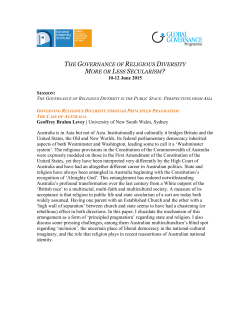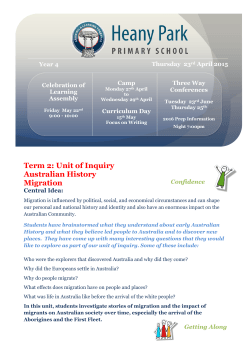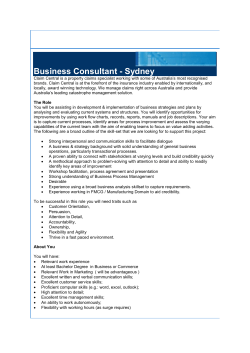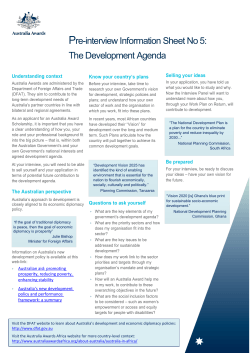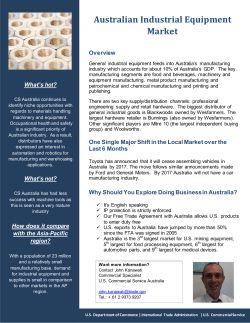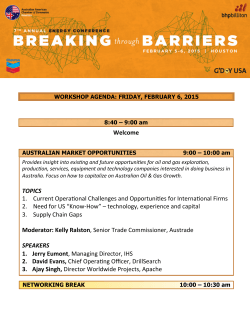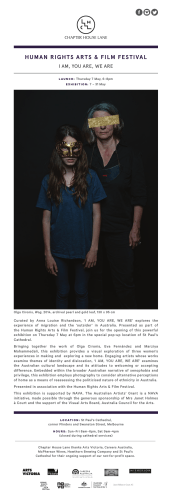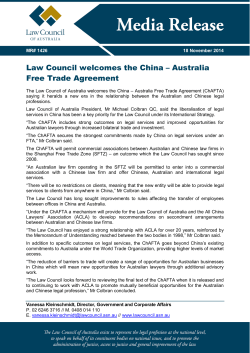
the WILPF Centenary TimeLine Posters
1915 An International Vision during the Trauma of War WILPF Australia 25 March 1915 During World War I, 30 women meet at the Australian Church in Melbourne and form the Sisterhood of International Peace with the motto ‘Justice, Friendship and Arbitration’. As Australian white women, they have the right to vote. They are confident that they have an important role to play in working for peace through negotiation. 28 April 1915 The Sisterhood of International Peace Committee. Source: State Library of Victoria As the British army, including Anzacs, is invading Turkey more than 1000 women from both warring and neutral nations meet in The Hague for the International Congress of Women. They set out resolutions for ending all war and resolve to take them immediately to all heads of state in Europe and the USA. They name themselves the International Committee of Women for Permanent Peace. The International Congress of Women in the Hague. Source: WILPF Archive: Geneva 15 July 1915 The Women’s Peace Army (WPA) is established in Melbourne to mobilise the women in Australia who oppose all war. Vida Goldstein, a fearless pacifist, is its driving force. As the far-sighted resolutions of the International Congress become known, both the women of the Sisterhood and the WPA affiliate with the International Committee of Women for Permanent Peace. Eleanor Moore, as international secretary “I know that the idea that lasting peace can be gained through war is nonsense” Eleanor Moore of the Sisterhood, joins the International Committee as it plans the second Congress. There is much common ground between these two women’s peace organisations. The WPA is activist and outspoken taking on almost every cause that affects women during the war. The Sisterhood places great emphasis on educating themselves on the causes of war, and on the education of the young for peace. Women’s International League for Peace and Freedom working for Peace, Disarmament and Human Rights for 100 years 1916-1925 WILPF Australia Stop War - Negotiate Peace 1916-1917 Anti-conscription Campaigns. Both the Sisterhood of International Peace and the Women’s Peace Army campaign vigorously against conscription for overseas service, in two referenda that divide the nation. They speak out publicly, write and distribute their own pamphlets. Both referenda are lost. Conscription is not introduced in Australia. May 1919 Three delegates from Australia attend the second congress in Zurich: Eleanor Moore from the Sisterhood, and Vida Goldstein and Cecilia John of the Women’s Peace Army. The International Committee adopts a constitution and the name the Women’s International League for Peace and Freedom (WILPF). Eleanor Moore Source: State Library of NSW “We must oppose war because it is based on fear and hate and lies” Vida Goldstein Vida Goldstein 1919 Source: National Library of Australia WILPF denounces the Treaty of Versailles as one of ‘revenge sowing the seeds of another world war’. Eleanor Moore remains in Europe helping Emily Greene Balch, WILPF’s first International Secretary, set up the International Secretariat. Later, she chronicles her lifelong commitment to peace and foundational work for WILPF in ‘The Quest for Peace as I have known it in Australia’ (1949). Disarmament Sunday, 6 November 1921. Source: State Library of Victoria 1920 1924 The Sisterhood becomes the Australian Section of WILPF and is based in Melbourne. The WPA disbands in early 1920 and many of its members join WILPF. During the 1920s WILPF branches form in Hobart, Newcastle, Perth, and Rockhampton. 1924 Charter of Peace - Safeguards Against Tyranny. WILPF Australia helps compile a Charter of Peace affirming principles of individual liberty. Edith Whitworth, WILPF Tas, presents this charter at the WILPF International Congress in Washington. Women’s International League for Peace and Freedom working for Peace, Disarmament and Human Rights for 100 years 1916-1917 WILPF Australia Campaigning against Conscription Source: State Library of Victoria Women’s International League for Peace and Freedom working for Peace, Disarmament and Human Rights for 100 years 1926-1930 WILPF Australia Building Peaceful Relationships 1927 After foreign tax gatherers are murdered in the Solomon Islands, British authorities plan a punitive action involving an Australian destroyer to attack a whole village as collective punishment. WILPF Australia alerts WILPF UK about this, and the two branches cause the issue to be raised in the Australian Parliament and in the House of Commons. The punitive expedition is cancelled. WILPF is able to build strong relationships with women of other Pacific countries 1928 Eleanor Moore joins the executive of the newly formed branch of the World Disarmament Committee in Melbourne. Their aim is to gain the support of the people of Australia for worldwide action for disarmament. Eleanor Moore attends the Pan-Pacific Union Conference in Honolulu as a WILPF representative together with two other Australian WILPF women. Australian Delegates and accredited visitors to the First International Women’s Conference of the Pan-Pacific Union, Honolulu, August 1928. Source: Bert Covell, National Library of Australia A WILPF Regional Conference chaired by WILPF International President Jane Addams follows. WILPF Australia continues to build strong and significant relationships with women of other Pacific countries, far in advance of anything attempted by governments. In Perth, WILPF women organise Armistice Day celebrations that are held annually for five years and attract a thousand people, including the Premier and dignitaries. WILPF Regional Conference in Honolulu 1928. Source: State Library of NSW Women’s International League for Peace and Freedom working for Peace, Disarmament and Human Rights for 100 years 1931-1935 WILPF Australia Campaigning for World Disarmament 1931 WILPF Australia enthusiastically collects signatures for a worldwide disarmament declaration initiated by WILPF International. The Section collects 117,740 signatures across Australia. WILPF Australia collects over 100,000 signatures for World Disarmament WILPF women with Disarmament Petitions. Source: State Library of Victoria 30 November 1931 At a memorable meeting in the Melbourne Town Hall convened by the League of Nations’ Union and the World Disarmament Movement, a procession of WILPF members presents bundles of signatures to the Prime Minister in the presence of politicians, leading churchmen and other prominent citizens. The speeches made recognise the magnitude and significance of their achievement. A similar accolade is given to WILPF women around the world when a total of 8 million signatures from 56 countries are presented in Geneva, 6 million gathered by WILPF women. Australia’s contribution is the highest percentage per head of population in the world. Source: State Library of Victoria 1932 Parading the WILPF petitions to the World Disarmament Conference in Geneva. Source: Records of WILPF, Swarthmore College Peace Collection The Geneva Conference on Reduction and Limitation of Armaments fails to achieve what the people of the world had hoped for. Eleanor Moore later writes in ‘The Quest for Peace’: ‘No peace aspiration of our time had held out so bright a prospect of fulfilment; none led to such utter disappointment.’ She looks with greater optimism toward Australia’s region of the world. Women’s International League for Peace and Freedom working for Peace, Disarmament and Human Rights for 100 years 1936-1945 Ponder the Waste of War – Unite for Peace WILPF Australia In the context of growing militarism, WILPF women restate their pacifist position and protest against large increases in and profit from armament expenditure. They call on women to unite for peace, to ponder the waste and tragedy of war and to insist that alternative and sane methods be used for settling disputes in an effort to save civilisation from disaster. 1939 Mabel Drummond Source: Janet Morice Mabel Drummond becomes WILPF President as Australia enters the war. A pacifist, she has lived through the First World War and was in close communication with her brother fighting overseas. In 1939, her son joins up and she has to face the horror of war all over again. WILPF women campaign against conscription of men, call for negotiations between the warring powers, oppose conscription of women for military service, support conscientious objectors, raise questions about the presence of US troops in Australia, and propose sending surplus Australian wheat to feed the hungry in fascist-occupied European countries. October 1939 WILPF women write to the Prime Minister, asking him to press for peace negotiations. 1942 Peacewards, the journal of both WILPF and The Peace Society, ceases publication when its founder and editor Dr Charles Strong dies. From 1915 to 1942, it was the principal forum and means of keeping all members of WILPF across Australia informed. Statement of principles Of the women’s international league for peace and freedom, 1934-1935. 1.War, the systematic mass killing of human beings, sanctioned and directed by responsible rulers, is the Supreme atrocity of the modern world. 2.International war and civil war both come under the same condemnation. 3.The W.I.L.P.F. exists as a living protest against the assumption that in the nature of things wars are bound to recur and that preparation for them is necessary. 4.War is a preventable evil and can be brought to an end whenever human beings make up their minds that they will tolerate no more of it. 5.Other and superior means are available for the solution of every problem that can possibly arise. Abolition of the military system would compel statesmen to have recourse to these more humane and intelligent methods. 6.To all chivalric, patriotic, picturesque and sentimental sanctions for war the W.I.L.P.F. opposes the experience of womanhood wherever war occurs. The miseries of want and destitution, and the unnameable outrages on women which accompany all war, completely falsify its claim to be an effective defender of the home and the family. Eleanor M. Moore The Quest for Peace p188 Women’s International League for Peace and Freedom working for Peace, Disarmament and Human Rights for 100 years 1946-1955 WILPF Australia Ban Nuclear Weapons 1946 WILPF Australia wants to ensure that the horrors of the atomic bombing of Hiroshima and Nagasaki are never repeated and vigorously campaigns for the banning of nuclear weapons. Doris Blackburn, WILPF member and the first Victorian woman elected to Federal Parliament, chairs the Ban the Bomb meeting in Melbourne on the first anniversary of the Hiroshima bombing. The meeting asks that all major weapons of mass destruction be outlawed and that scientific research be free from military and political control. Doris Blackburn forces debate in parliament on a Bill to establish the Woomera Rocket Range in central Australia on Aboriginal land, a Bill which would violate Aboriginal human rights. Doris Blackburn (R) with her secretary Gloria Canet, at work in her Melbourne office c1940s. Source: National Library of Australia 1947 Doris Blackburn is the only MP to speak against the Labor government’s Defence Projects Protection Act, which imposes heavy penalties for public criticism of these projects. Source: Blackburn papers, State Library of Victoria Source: Hansard, House of Representatives, 6 March 1947 1948 1952 The WA branch, with support of the Australian Section, urges the government to use Western Australian wheat supplies that lie unused in silos across the state, to feed the hungry in China, Greece and other countries in need. With Anna Vroland as secretary of the Australian Section, WILPF becomes the first organisation in Australia to protest publicly against nuclear testing at Monte Bello and at the Woomera Rocket Range, as well as campaigning for full citizenship rights for Aboriginal people. The WA branch is re-established by Nancy Wilkinson. Women’s International League for Peace and Freedom working for Peace, Disarmament and Human Rights for 100 years 1956-1965 WILPF Australia Human Rights in Australia and Abroad 25 February 1960 Margaret Holmes forms a WILPF NSW branch from her Sydney home. 1962 WILPF campaigns against US bases in Australia. Margaret Holmes Arguing against Church approval of Australian involvement, Margaret Holmes (far right) and WILPF women picket Sydney Airport as Anglican Archbishop, Dr Gough, departs to visit Australian troops in Vietnam. November 1965. Source: Michele Cavanagh 1964-1965 1963 Both the Queensland and the Tasmania branches actively campaign against war toys. In Brisbane, a Tram Ride for Peace for children is organised prior to Christmas in 1965. WILPF women decorate a tram with posters and balloons bearing the message No War Toys please and many children enjoy a fun ride through the streets of Brisbane. WILPF begins opposition to French nuclear tests in the Pacific. WILPF NSW member Jean Richards travels to Paris to plead with President de Gaulle to stop the tests. NO R WA S O T YAS E PLE The Queensland Branch reopens, taking up the issue of equal rights for Indigenous Australians. Indigenous poet Kath Walker (later known as Oodgeroo Noonuccal) accepts honorary Life Membership. In Tasmania, Dr. Mildred Thynne, a Quaker from England, organises a meeting of 30 women and as a result the Tasmania branch is re-established. 1964 WILPF NSW hangs a huge banner with the wording “You Go To An Unjust War” over the cliff at the North Head of Sydney Harbour when the first troopship of conscripts sails for Vietnam. WILPF SA is revitalised by Margaret Forte and Maud McBriar, and organises a nation-wide Anti-war Song Competition. A tram ride for Peace, organised by WILPF QLD. WILPF’s 50th Anniversary Congress at The Hague launches a drive for signatures from the world’s leading women, asking women of the US to help stop the Vietnam War. A member of WILPF NSW, Lorraine Moseley, coordinates this appeal. Women’s International League for Peace and Freedom working for Peace, Disarmament and Human Rights for 100 years 1966-1974 WILPF Australia Protesting against the Vietnam War WILPF opposes Australia’s participation in the Vietnam war, with militant non-violent action, including dissemination of facts about the causes of the war, support for conscientious objectors to military service and draft resisters. WILPF women join with other organisations to hold regular silent vigils in most capital cities. Victorian women hold a weekly lunchtime vigil outside the Victorian State Library for five years. The Women in Mourning in Sydney stand in silence, dressed in black, and distribute leaflets to passers-by. WILPF women join weekly Sydney Peace Vigil, Wynyard Park. 1967. Margaret Holmes third from left. Source: Tribute/Search Foundation/State Library of NSW 1969 Margaret Holmes of WILPF NSW convenes a WILPF Chemical and Biological Warfare (CBW) sub-committee. 20,000 copies of the leaflet ‘What is CBW?’ are published and distributed to Federal MPs, the medical profession and the general public. Their booklet ‘New Perversions of Science’ warns of further dangers of chemical and biological weapons. Shirley Abraham from WILPF VIC represents WILPF at the Federal Council of Aboriginal and Torres Strait Islanders (FCAATSI) Conference. SA anti Vietnam rally - one of the many such marches over ten years. Source: The Adelaide Advertiser 1966 WILPF SA organise the first anti-Vietnam War march held in South Australia. WILPF VIC secretary Fran Boyd coordinates an ‘Appeal to Help Stop the War in Vietnam’ to State and Federal Members of Parliament and a ‘Woman’s Appeal’ to the Australian Government. 1968 1970 WILPF women around Australia participate in Australian Vietnam Moratorium campaigns. 1973 WILPF SA publishes the booklet ‘American Bases in Australia’ for the Australian Section. WILPF QLD women picket the premises of Dow Chemicals, the manufacturers of napalm being used in Vietnam. Women’s International League for Peace and Freedom working for Peace, Disarmament and Human Rights for 100 years 1975 WILPF Australia Equality, Development and Peace International Women’s Year (IWY) sets ‘Equality, Development and Peace’ as goals for the UN Decade for Women. WILPF continues to stress the prime importance of peace if equality and development are to be achieved. WILPF Australia prepares a submission against uranium mining and testifies before the Ranger Uranium Enquiry. WILPF writes to the Prime Minister expressing alarm at developments in East Timor, supporting East Timorese selfdetermination, opposing military intervention and supporting a UN peacekeeping force. Three Australian WILPF women attend the UN World Conference and the NGO Tribune in Mexico. Eight Australian Women are featured in the WILPF International 60th anniversary publication ‘Listen to Women for a Change,’ including, Irene Greenwood, Margaret Holmes, Elizabeth Reid and Kath Walker. Australian WILPF women attend the IWY Women and Politics Conference in Canberra and lead sessions on ‘Can Women Provide the Peacemakers?’ and ‘Peace Games.’ WILPF SA convenes the local IWY Peace Sub-Committee, organises a well-attended seminar on ‘Handling Aggression’ and publishes the papers. WILPF VIC and WILPF TAS each establish a peace library in their state. Evelyn Rothfield attends the WILPF International Executive Meeting in Hamburg and the International Women’s Congress in Berlin chaired by Australian Freda Brown. A Peace Studies program, long campaigned for by WILPF WA is introduced at Murdoch University. WA member Betty King becomes registrar of Perth-based Peace Institute of Australia. Women’s International League for Peace and Freedom working for Peace, Disarmament and Human Rights for 100 years 1976-1980 WILPF Australia A Nuclear - Free Pacific 1978 The United Nations holds a Special Session on Disarmament. WILPF branches promote seminars and conferences in their own states and participate in Peoples Disarmament Conferences in Melbourne and Sydney. WILPF urges the Australian Government to provide stronger incentives for scientists working on nonnuclear alternative energy. 1979 During the International Year of the Child, WILPF SA coordinates a national submission to the Prime Minister on the health, education and housing of Aboriginal children. WILPF NSW member Stella Cornelius works with the United Nations Association of Australia (UNAA) to establish the UNAA Media Peace Prize that recognises the vital role the media can play for peace. Thousands of Sydneysiders, amongst them WILPF women March on Sunday 7 April 1979, against uranium mining. Source: Green Left Weekly The Section continues to campaign against uranium mining in Australia. 1980 WILPF branches support action for Aboriginal land rights. They campaign for the Pitjantjatjara Land Rights Bill (SA) and support Aboriginal opposition to mining on Aboriginal land at Noonkanbah (WA). WILPF branches are involved in the Nuclear Free Pacific Forum in Sydney, the first held in Australia, and the Indian Ocean Zone of Peace conference in Fremantle. WILPF Australia and the UNAA establish the Junior Media Peace Prize (JUMPP), to encourage children to prepare material for publication in the media. WILPF Australia is a member of the committee proposing an Australian Peace Research Institute to be funded by the Defence budget. JUMPP - an initiative of WILPF and UNAA Women’s International League for Peace and Freedom working for Peace, Disarmament and Human Rights for 100 years 1981-1985 Protesting for a Peaceful and Independent Australia WILPF Australia 1981 The Australian government offers the US military bases for nuclear-capable B52 bombers, and increases arms expenditure. Alarmed, WILPF urges the Prime Minister to work for an independent foreign policy instead. WILPF publishes Alternatives to War - The Peaceful Settlement of International Disputes by Dr Keith Suter. Source: Canberra Women for Survival 1982 1983 WILPF Australia holds its biennial meeting in Canberra for the first time. An ACT branch is formed and sends Nancy Shelley to the Second UN Special Session on Disarmament in New York. WILPF members participate in Palm Sunday peace rallies. WILPF women participate in the Women for Survival Peace Camp at Pine Gap near Alice Springs. It is the first significant protest against the location of an American military base on Australian soil. A supporting peace camp is held simultaneously at the American War Memorial in Canberra. 1984 WILPF women take part in the Cockburn Sound Women’s Peace Camp near Stirling Naval Base in WA to protest against visits of nuclear capable US warships. Veteran WA WILPF member, Irene Greenwood, is honoured by having a Stateline flagship named after her. Irene Greenwood 1985 WILPF Australia organises the Australian Pacific Women’s Peace Conference in Sydney for delegates en route to the NGO Forum in Nairobi held in association with the UN World Conference at the end of the Decade for Women. Many Australian WILPF women attend. WILPF inaugurates the Peace Tent. Report of Australian Pacific Women’s Peace Conference. Pacific women in the WILPF Peace Tent at the UN Forum for Women in Nairobi. Women’s International League for Peace and Freedom working for Peace, Disarmament and Human Rights for 100 years 1986-1989 WILPF Australia Messengers of World Peace 1986 During the International Year of Peace (IYP), WILPF Vice President Stella Cornelius is appointed Executive Director of Australia’s IYP Secretariat. WILPF members serve on IYP Committees recommending construction of a Peace Memorial in Canberra, and undertake IYP projects, especially concerning Education for Peace. Stella Cornelius WILPF WA organises the Indian Ocean Zone of Peace Conference. The 5 Questions put to the Heads of State of all UN member nations WILPF SA initiates ‘twinning’ of Adelaide with the cities Minsk (USSR) and St Louis (USA). The Great Peace Journey, originating in Scandinavia, is brought to Australia by Elisabeth Gerle (WILPF Sweden). WILPF Australia co-ordinates its deputations to Australia and Pacific UN member governments. 1987 WILPF Australia sends Aboriginal member Kay Mundine to the World Congress of Women in Moscow. WILPF International receives a UN Peace Messenger award and WILPF Australia receives one of the nine awards that came to Australia. Source: Collen St Ledger 1988 Elisabeth Gerle, WILPF Sweden, second L, leads the Great Peace Journey delegation. WILPF joins in nation-wide opposition to visits of nuclear-armed and/or powered warships during the Australian Bicentennial celebrations and in Aboriginal non-violent protests at opening of the new Parliament House in Canberra. 1989 WILPF continues to support Aboriginal claims for land rights and self-determination, and acknowledges Aboriginal sovereignty. WILPF Australia hosts the WILPF 24th International Triennial Congress in Sydney, a first for the Southern hemisphere. It includes a seminar for Indigenous Women and Women from Developing Countries. More than 40 women from around the world participate in this seminar. Women’s International League for Peace and Freedom working for Peace, Disarmament and Human Rights for 100 years 1990-1995 WILPF Australia Peace Journeys 1990-1991 WILPF joins in worldwide efforts to prevent war in the Middle East. 1991 WILPF joins protests against the AIDEX Arms Trade Fairs in Canberra finally leading to a ban on such trade fairs in the capital. WILPF ACT women stand on street corners holding posters against the arms trade. AIDEX protest poster held on street corners in Canberra Civic in 1991. 1993 WILPF Australia is involved in creating CAPOW (Coalition of Participating Organisations of Women), a national NGO network, in preparation for the UN Conference on Women in Beijing in 1995. 1994 WILPF international sends a mission to monitor elections in South Africa that includes WILPF ACT member Ronis Chapman. 1995 rney. Map of the Peace Train Jou WILPF Peace Train from Helsinki to Beijing Ten Australian women join the WILPF Peace Train from Helsinki to Beijing for the UN Fourth World Conference and Forum on Women. WILPF hosts the Peace Tent at the Forum and WILPF Australia Alison Cooke, Marilyn Clement, Hellen Cooke and Ruth Corrigan. Outside the WILPF Peace Tent at the UN NGO Forum, Huairou, held in association with UN Conference for Women, Beijing, 1995. members are active in the Peace Caucus that drafts the Peace Statement later read by the Vice President of WILPF to the conference. The Peace Journey provides great inspiration and energy for WILPF in Australia through those who participate. Women’s International League for Peace and Freedom working for Peace, Disarmament and Human Rights for 100 years 1996-2002 WILPF Australia Women in the Peace Process 1997 WILPF Australia participates in the Australian Reconciliation Convention. 1998 WILPF Australia participates in the Women’s Constitutional Convention, Canberra, and recommends the introduction of a nonbelligerency clause similar to that in the Japanese Constitution. Left to Right: Ruth Corrigan, Margot Pearson and Hellen Cooke at the Women’s Constitutional Convention. 2002 Implementing Resolution 1325 2000 From 2002 onwards, WILPF leads the way in working for the Australian implementation of 1325 through the development of a National Action Plan. WILPF ACT forms the national WILPF 1325 Working Group with Margaret Bearlin as convenor. WILPF women organise workshops for women’s organisations, locally and nationally, and speak at international conferences within Australia. WILPF takes a prominent role in organising the World March of Women (WMW) in Australia. Cathy Picone (SA) coordinates a nation-wide postcard campaign and Lyn Lane (ACT) takes part in the WMW delegation for international meetings in Washington and New York. WILPF ACT initiates an NGO network for submissions to the Australian Defence White Paper 2000, prioritising the security of people and planet. Historic first UN Resolution on Women and Peace. WILPF, through Felicity Hill, Director of the WILPF UN Office, plays a significant role in facilitating the adoption of the historic UN Security Council Felicity Hill, Director Resolution 1325 ‘Women, of the WILPF UN Office. Peace and Security’, and in establishing the Peacewomen Project. The Resolution highlights the impact of war and conflict on women and the importance of women’s involvement in peace building. 1325 UN Security Council Resolution 1325 (2000) “Women , Peace and Security” • W omen’s full and equal participation in every aspect of the peace process: conflict prevention, negotiating peace agreements, peacekeeping operations, post-conflict reconstruction and reconciliation, and peace building. • T he protection of women and girls and their human rights in conflict zones with no impunity for those who violate these rights. • T he provision of gender sensitive training in peace keeping operations. • G ender mainstreaming in the reporting and implementation systems of UN relating to conflict, peace and security: every decision to be scrutinised for its impact on women. Women’s International League for Peace and Freedom working for Peace, Disarmament and Human Rights for 100 years 2003-2005 WILPF Australia Standing for Peace and Against Violence 2003 All WILPF branches actively campaign against the war in Iraq, take part in protests, rallies and the largest world peace march on February 19. Ruth Russell, WILPF SA goes to Iraq as a Human Shield. WILPF purchases ‘The Children of the Gulf War’ photographic exhibition on the effects of depleted uranium on the children of Iraq. An initiative of Chris Henderson of WILPF QLD, it is shown in major centres and rural areas of Australia. Safaa, an eight year-old girl is smiling because she is checking out of hospital to go home. When her shawl blows off in the wind her smile disappears for she has no hair, a side effect of the medication she has been given for her leukemia. She isn’t aware that she is going home because the hospital has run out of medicine. Source: Takashi Morizumi May, 1998. 2003 onwards Women in Black standing in Silent Vigil in Canberra. WILPF women in Adelaide, Canberra and Melbourne stand as Women in Black in silent vigil for peace with justice, and actively opposed to injustice and all forms of violence. 2004 2005 WILPF launches the www.1325australia website, designed to further the implementation of SCR 1325. The WILPF ACT coordinates the Australian leg of the World Relay of the Women’s Charter for Humanity and hosts the arrival of the Women’s Charter in Australia. Six Australian WILPF women attend the first WILPF Asia-Pacific Regional meeting in Christchurch, Aotearoa-NZ. Decolonisation and self-determination are the main focus. WILPF ACT holds a week long Festival of Peace: celebrating WILPF’s 90th Anniversary, together with Women in Black and A Chorus of Women, with displays, speakers and workshops. WILPF ACT Festival of Peace celebrating WILPF’s 90th Anniversary. Women’s International League for Peace and Freedom working for Peace, Disarmament and Human Rights for 100 years 2006-2010 Resisting Militarism: Reclaiming our Peace History 2006 WILPF Australia April 2008 WILPF women attend the Australia 2020 Summit, proposing that Australia’s commitment to gender equality be reflected in domestic and foreign policy. September 2008 Performers for Peace in Brisbane “I didn’t raise my boy to be a soldier”. WILPF QLD forms a street theatre group, Performers for Peace, which writes and performs skits about women and peace. WILPF receives a grant to fund background research and consult with women’s and human rights organisations to gauge community support for a Women, Peace and Security National Action Plan (NAP). 2009 2007 WILPF opposes the joint military exercises of Australia and the US at Shoalwater Bay in the Great Barrier Reef Marine Park. Members participate Hellen Cooke in the Talisman Sabre 2007 Peace Convergence at Shoalwater Bay to protest against the military exercises. Inspired by Hellen Cooke, they write to the Mayor of Rockhampton proposing ‘Peace Games’ rather than ‘War Games’. Concerned about increasing militarism, WILPF ACT members inaugurate a silent vigil on Anzac Day at the Canberra Peace Memorial. It becomes an annual event. 2008 2010 WILPF TAS establishes the Eve Masterman Peace Poetry Prize on Eve Masterman’s 100th birthday. It pays tribute to her tireless commitment to humanitarian and anti-war campaigning. For WILPFs 95th birthday, the Queensland branch establishes the WILPF Peacewomen Awards that recognise ‘the talents and dedication of women whose activities have promoted peace’. Three presidents: Dr Margot Roe, Eve Masterman and Audrey Moore, on Eve’s 100th birthday. WILPF ACT prepares a national submission in response to the Defence White Paper 2009. Members from several branches speak at public consultations. Professor Marilyn Lake At WILPF ACT’s celebration, Professor Marilyn Lake speaks on ‘Rediscovering Australia’s Peace History’, underlining the significance of WILPF women in Australia’s peace history. Women’s International League for Peace and Freedom working for Peace, Disarmament and Human Rights for 100 years 2011-2014 WILPF Australia Women as Peace Builders 2011 21-25 April 2014 WILPF participates in global campaign of 16 Days of Activism Against Violence Against Women on ‘Blow the Whistle to Redefine Security.’ Women meet in public and blow whistles to draw attention to this problem. WILPF women attend the IPAN (Independent and Peaceful Australia Network) Easter Convergence in Canberra. 25-27 April 2014 The WILPF Asia-Pacific Regional Meeting is held in Auckland with the theme ‘Militarism in the Pacific.’ Ten Australian WILPF women attend. YWILPF, Sharna da Lacy and Cara Gleeson with other WILPF women at Commission for the Status of Women, New York 2014. Young WILPF (YWILPF) begins in Australia. YWILPF sets up a website, raises funds to bring young women from the Pacific to Australia for radio training, offers feminist courses, and participates in Women, Peace and Security (WPS) advocacy. 2012 WILPF Asia-Pacific Regional Meeting. 2014 The final Australian National Action Plan on Women, Peace and Security (WPS) 2012 -2018 is launched on International Women’s Day. Australian WILPF women prepare for the 2015 Centenary writing WILPF’s history, organising exhibitions and events, and preparing to attend the Centennial Congress in The Hague in April 2015. April 2013 In the midst of the glorification of war that accompanies the commemoration of World War I and the Anzac Centenary in Australia, they reclaim the Principles of Permanent Peace and Women’s Power to Stop War. Barbara O’Dwyer, WILPF National Co-ordinator, organises a national NGO Forum on 1325 in February 2013 and plays a key role in organising the first Annual Civil Society Dialogue on Women, Peace and Security (WPS) bringing together Government and civil society representatives to report on the first year of the implementation of the WPS NAP. A WILPF representative attends consultations held by the Department of Foreign Affairs on Australia’s seat on the UN Security Council. First Annual Civil Society Dialogue on the WPS National Action Plan 2013. Barbara O’Dwyer, third from right. Women’s International League for Peace and Freedom working for Peace, Disarmament and Human Rights for 100 years 2015 WILPF Australia Celebrating a Century In 1915 over a thousand courageous women came together to stop a war and formed an international women’s league for peace and freedom. In 2015 WILPF will once again gather women from all over the world in an international movement to promote women’s unique power to stop and prevent wars and establish the necessary foundations for permanent peace. Join us at WILPF centenary celebrations in The Hague, in Canberra and in WILPF branches throughout Australia, to establish a new peace agenda for the 21st century. We know now what we knew then, that only when we analyse conflicts from a gender perspective, integrating disarmament, human rights, the environment, social justice and the women, peace and security agenda holistically, will we be able to eradicate the root causes of conflict. Australian Celebrations in Canberra Feb 21 – May 31 WILPF Centenary Exhibition, Women’s Power to Stop War, Canberra Museum and Gallery April 11 PeaceKnits Pop Up Event, Queanbeyan April 28 – May 2 International Celebrations A Passion for Peace Festival, Albert Hall www.chorusofwomen.org in The Hague, Netherlands May 28 April 17 – 21 May 29 Peace Train from Instanbul to The Hague, Netherlands WILPF National Peacewomen Awards, ANU April 22 – 25 WILPF Women’s Power to Stop War Australian Conference, Australian National University WILPF Centennial Congress, The Peace Palace May 30 April 27 – 29 WILPF 2015 International Conference, World Forum WILPF Triennial Congress, University House, Australian National University www.womenstopwar.org www.wilpf.org.au/centenary Women’s International League for Peace and Freedom working for Peace, Disarmament and Human Rights for 100 years
© Copyright 2025
